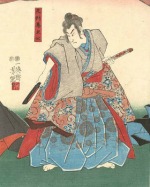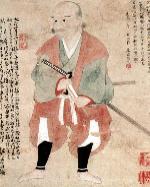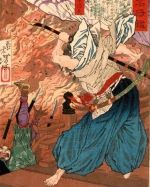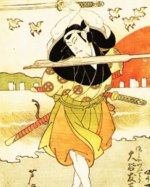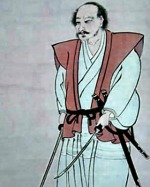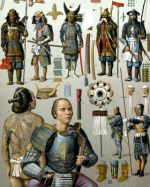Samurai Warriors of the Heian Period (794 – 1185)
Talk the Talk
The word Shogun actually means Barbarian Subduing General. This is in reference to the first men who held the office, who were charged with the task of subduing the Ainu.
Walk the Walk
At this time, warriors usually fought on horseback and the bow was their weapon of choice.
The Japanese samurai’s sword was mainly used for close-in fighting and for collecting the heads of defeated enemies, which were then delivered to the warlord to show the number of important kills a samurai warrior had achieved in a particular battle.
The Japanese samurai’s sword was mainly used for close-in fighting and for collecting the heads of defeated enemies, which were then delivered to the warlord to show the number of important kills a samurai warrior had achieved in a particular battle.
Samurai History Fact
During the eleventh century, Japanese literature saw the introduction of the code of ethics that laid out the rules that a warrior should live by, known as Bushido (Way of the Warrior).
This code would replace an earlier code which was known as Kyusen no Michi (Way of the Bow and Arrow).
This code would replace an earlier code which was known as Kyusen no Michi (Way of the Bow and Arrow).
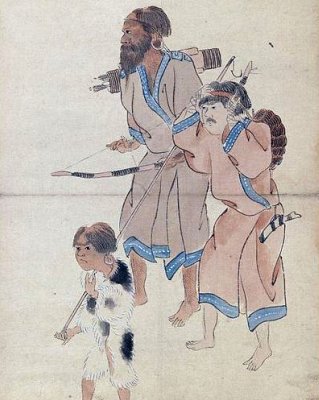 The Heian Period is an important time in the history of the martial arts as it represents the establishment of a new social class in Japan, a class of samurai warriors. They were formed initially as a result of fighting the Northern tribes, a distinct race known as the Ainu who are believed to be descended from some of the earliest inhabitants of the country and can still be found in the North of Japan to this day.
The Heian Period is an important time in the history of the martial arts as it represents the establishment of a new social class in Japan, a class of samurai warriors. They were formed initially as a result of fighting the Northern tribes, a distinct race known as the Ainu who are believed to be descended from some of the earliest inhabitants of the country and can still be found in the North of Japan to this day.The Birth of the Japanese Samurai
The land between the capital city of Kyoto and the North traditionally acted as a buffer zone that served to insulate the emperor from the fighting. As a result, the borderlands produced the best soldiers the country had to offer and the landowners who controlled these warriors were given the task of subduing the Ainu, considered by the Japanese to be barbarians.With the eventual subduing of the Ainu, the warrior families of the borders who had fought them for generations were rewarded with tax-exempt territories. The heads of the clans were believed to be able to trace their lineage back to the gods and their men were of high-born status. They became known as samurai warriors and they believed in loyalty to their warlord above all else.
From the early ninth century, the various powerful families in Japan started to compete against each other, with the strongest increasing their holdings through the spoils of war. From this, three powerful rivals emerged, the Fujiwara, the Taira and the Minamoto clans.
The Fujiwara, the Taira and the Minamoto
The first of these clans to dominate was the Fujiwara, who had close ties with the emperor. By around 850, the Fujiwara Clan controlled the emperor and his government almost completely as they held most administrative and military posts of any importance. The head of the family would be a regent to child emperors and would be the first minister to an adult emperor.For centuries, when an emperor of Japan married, it would be to a Fujiwara bride putting the clan in a perfect position to rule the country with the emperor becoming no more than a puppet, controlled by the head of the Fujiwara family. However, throughout the Heian Period, the insulated government became weaker and weaker and its hold on power outside of the capital diminished; as a result, so too did the overall power of the Fujiwara Clan.
The Taira and the Minamoto clans were growing in strength between the tenth and twelfth centuries by defeating weaker, neighbouring clans and taking their lands and wealth. The two clans would have two major conflicts that would ultimately bring about the end of the Heian Period. In 1160, Yoshitomo Minamoto was defeated by Kiyomori Taira. Unusually for those times, three of his sons were allowed to live, Yoshitsune, Noriyori and Yoshitomo’s heir Yoritomo. However, this proved to be a mistake as both Yoritomo and Yoshitsune decided to learn martial arts from a young age in a bid to avenge their father’s death.
Both grew up to be great warriors and samurai legends that, in a series of decisive battles known as the Gempei Wars, defeated the Taira clan leaving Yoritomo Minamoto as the ipso-facto ruler of Japan. Yoritomo then cemented his position with a number of political changes and brought an end to the age in which the samurai legend was first born, the Heian Period, and in its place in 1185, the Kamakura Period began.
Written by Andrew Griffiths – Last updated 11/09/2023. If you like
what you see, consider following the History of Fighting on social media.
Further Reading:
Brief History of the Samurai. [Internet]. 2012. Michigan University. Available from: http://www-personal.umich.edu/~malokofs/SCA/Persona/History/samurai.html [Accessed 13 November, 2012].Cook, H. 1993. Samurai – The Story of a Warrior Tradition. London. Blandford Press.
Heian Japan: An Introductory Essay. [Internet]. 2010. Colorado University. Available from http://www.colorado.edu/cas/tea/curriculum/imaging-japanese-history/heian/essay.html [Accessed 13 November, 2012].
Heian period c. 800 -1200. [Internet]. 2012. Elon University. Available from: http://facstaff.elon.edu/sullivan/h&ktimes.htm [Accessed 13 November, 2012].
The Samurai of the Heian Period (794 – 1185). 2009. Socyberty. Available from: http://socyberty.com/military/the-samurai-of-the-heian-period-794-1185/ [Accessed 13 November, 2012].
More Samurai History
Samurai History Home
A brief overview of the history of the samurai, looking at the rise and development of the leading social class in Japan and some of the cultural traits than made the samurai warriors unique such as their weapons and their code of ethics, known as bushido.
A brief overview of the history of the samurai, looking at the rise and development of the leading social class in Japan and some of the cultural traits than made the samurai warriors unique such as their weapons and their code of ethics, known as bushido.
Tomoe Gozen – Female Samurai Warrior
Tomoe Gozen is a rare example of a female Samurai warrior and is believed to have been involved in the Gempei wars (1180 – 1185). She fought alongside her Master, Minamoto Yoshinaka, though it is unclear how much of her story is actually true.
Tomoe Gozen is a rare example of a female Samurai warrior and is believed to have been involved in the Gempei wars (1180 – 1185). She fought alongside her Master, Minamoto Yoshinaka, though it is unclear how much of her story is actually true.
Yoshitsune Minamoto
The tragic tale of samurai legend Yoshitsune Minamoto. After helping his brother Yoritomo win the Genpei War and gain control of Japan, he was denied the titles and rewards he should have received for his services and was ultimately hunted down as a traitor.
The tragic tale of samurai legend Yoshitsune Minamoto. After helping his brother Yoritomo win the Genpei War and gain control of Japan, he was denied the titles and rewards he should have received for his services and was ultimately hunted down as a traitor.
The Kamakura Period
A look at the change and turmoil experienced by the ruling elite of Japan during the Kamakura Period and the Kemmu Restoration. A series of civil wars and two invasions from the Mongols saw powershifts not only between rival families, but also between the titles of the Emperor, the Shogun and the Regent.
A look at the change and turmoil experienced by the ruling elite of Japan during the Kamakura Period and the Kemmu Restoration. A series of civil wars and two invasions from the Mongols saw powershifts not only between rival families, but also between the titles of the Emperor, the Shogun and the Regent.
The Mongols vs. The Samurai
While the samurai warriors of the late thirteenth century were formidable warriors in their own right, when faced with the onslaught of the Mongol Hordes they seemed to be fated to lose. They were outclassed in every way by however things did not go according to plan for the foreign invaders.
While the samurai warriors of the late thirteenth century were formidable warriors in their own right, when faced with the onslaught of the Mongol Hordes they seemed to be fated to lose. They were outclassed in every way by however things did not go according to plan for the foreign invaders.
The Japanese Samurai Sword
The samurai sword, it is said, was believed to contain the soul of the warrior who owned it. While this is probably an over romanticised view, it is true to say that there was a spiritual connection not only for the wielder of the katana, but also for the sword smith and his creation.
The samurai sword, it is said, was believed to contain the soul of the warrior who owned it. While this is probably an over romanticised view, it is true to say that there was a spiritual connection not only for the wielder of the katana, but also for the sword smith and his creation.
The Muromachi Period
The Muromachi Period was a time of turmoil in Japan that can be spilt into two separate eras. At the beginning of the period, the government was divided into two separate entities sparking the Northern and Southern Courts Era. Then, after a brief period of relative stability, the Warring States Era began.
Tsukahara Bokuden
Tsukahara Bokuden was a samurai warrior who lived in the 16th century. In his early days he exemplified what a samurai should be and was known as one of the fiercest warriors around. However in later life, Bokuden would take on a more pacifist philosophical stand point.
Tsukahara Bokuden was a samurai warrior who lived in the 16th century. In his early days he exemplified what a samurai should be and was known as one of the fiercest warriors around. However in later life, Bokuden would take on a more pacifist philosophical stand point.
The Azuchi-Momoyama Period
The Azuchi-Momoyama Period was characterised by the unification of the samurai clans after years of unrest and civil war. First, Nobunaga Oda managed to wrest control of much of the archipelago, and his successes were then built upon by Hideyoshi Toyotomi. The latter also brought social reforms to Japan, many of which would last nearly 300 years, though not all were for the better, especially for an ambitious peasant.
The Death of a Samurai
The manner in which a samurai died was very important and if possible, it would be during combat in a way that would be told in samurai stories for years to come. Failing that, he should die in some other service to his lord or if his honour depended on it, in a ritualistic suicide known as seppuku.
The manner in which a samurai died was very important and if possible, it would be during combat in a way that would be told in samurai stories for years to come. Failing that, he should die in some other service to his lord or if his honour depended on it, in a ritualistic suicide known as seppuku.
The Duels of Miyamoto Musashi
Miyamoto Musashi is one of the most acclaimed samurai that ever lived. While undertaking a warrior’s pilgrimage, he fought in over 60 duels dispatching the best swordsmen in a given area, often in fights to the death.
The Samurai at War
The main business of the samurai was war and while tactics and weapons changed through the years, the willingness to die for their lord was a constant. In return, they could gain riches and status, as well as the best of them gaining a kind of immortality by having stories told about them for centuries to come.
The main business of the samurai was war and while tactics and weapons changed through the years, the willingness to die for their lord was a constant. In return, they could gain riches and status, as well as the best of them gaining a kind of immortality by having stories told about them for centuries to come.
The images on this site are believed to be in the public domain, however, if any mistakes have been made and your copyright or intellectual rights have been breeched, please contact andrew@articlesonhistory.com.

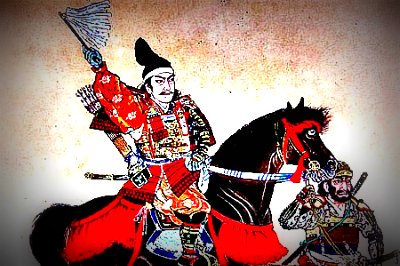
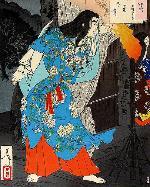
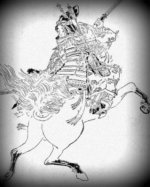
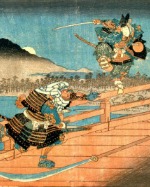
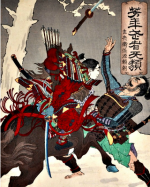
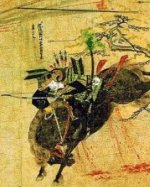
 thumb.jpg?timestamp=1582719937303)
